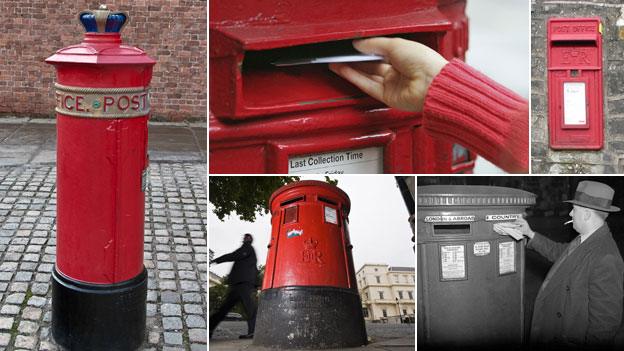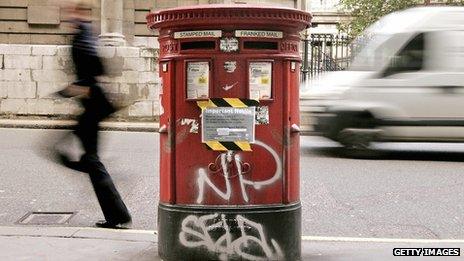Letter boxes: The red heart of the British streetscape
- Published

One of the UK's rarest postboxes is celebrating its 150th anniversary. But what is the future for the red emblem of the British streetscape?
Of the 115,000 or so postboxes dotted around the country, only a single "Liverpool Special" still graces a public space, in the city's Albert Dock.
It is a rare example of a piece of street furniture that perhaps more than any other object helps create a quintessentially British landscape.
The red phone box is (largely) gone. The red postbox remains.
The denizens of conservation areas still jealously hang on to their heritage phone boxes. But will the red postbox face the same fate, reduced to a pleasant rarity?
Many of us still give directions to our own homes using the cast-iron box as a landmark. Its design has changed little since 1879.
For many communities, they are a reassuring presence - a cheerful, red splash that has stood out on British streets for a more than a century and a half.
But with privatisation looming - possibly this year - are other colours set to usurp the familiar red?
There is now an inexorable shift to email from the traditional letter. The peak for Royal Mail deliveries was in 2005-06 when some 84 million items were delivered every working day. Today it's roughly 58 million, according to Royal Mail.
Much of that is business mail that never plops through a traditional postbox.
The first pillar boxes were erected at St Helier in Jersey in 1852, at the recommendation of novelist Anthony Trollope - who was an employee of the General Post Office at the time. The first boxes were erected in Britain a year later.
Designs varied but in 1859 an improved cylindrical design was adopted for standard use nationwide. A Liverpool postmaster decided to rebel, and after a waging a long battle with London, the Liverpool Special letter box - with its increased capacity and chunkily cast crown on top - was born.
The Letter Box Study Group , external(LBSG), which maps sites across the UK, is not just concerned with this postal oddity today, but with the fate of all the boxes.
In 2002, Royal Mail undertook to repaint each of its letter boxes every three years.
But, according to Andrew Young, chairman of the LBSG, many are not being properly maintained.
"There was a massive amount of publicity about the painting of the gold boxes during the Olympics and Paralympics," he says.

"Walk into any tourist shop and you will see post boxes replicated in miniature as souvenirs. But look at some of them on the street, they are poorly painted, collection plates are missing. They should be doing more to maintain them - there is lack of pride in their presentation.
"In some rural areas and towns, the letter boxes look like they haven't been painted for 10 or 20 years."
But the Royal Mail denies it has been neglecting its letter boxes, saying a great deal of effort goes into maintaining and painting them.
"We repaint and refurbish them on a regular basis," says spokesman Nick Martens. "We also respond directly to reports by our staff and customers about individual boxes that require urgent attention."
Young's view, however, is that in a deregulated system, there could be a decline in numbers of the traditional form of the red boxes.
"There is a question over who would become responsible for the heritage," says Young. "It would take a campaign to determine who had liability."
The Postal Services Act 2011, external, which paved the way for privatisation, makes reference to "an operator's 'postal infrastructure'" which, it says, includes "physical infrastructure (such as letter boxes)". But the act does not specify what colour those boxes should be.

What would happen if, say, a firm bought a stake and wanted some of the boxes painted orange? As it stands there's no specific legal barrier.
A Department for Business, Information and Skills spokeswoman, however, says: "Royal Mail is 100% committed to keeping red postboxes as they are. Any change is beyond the realms of even the most fertile imagination."
When the bill was making its way though Parliament, Conservative MP for Kettering Philip Hollobone called for legal protection for red boxes, which he said could be lost forever.
There is formal legal protection for the image of the monarch on stamps.
Young says he does not "expect a wholesale removal". A private operator that didn't feel the need to use letter boxes could just leave them there, shuttered. But who would maintain the paintwork?
Would residents groups have to effectively adopt them and keep the red paint handy? The same was done for many remaining red telephone boxes.
The traditional letter box has many fans.
Jonathan Glancey, writer and author of Pillar Boxes, sees them as miniature works of architecture, as a "glorious piece of public design", both functional and aesthetic, that has stood the test of time.
"Functionality was key but they were part of the school of design when every-day objects were handsome, regular and standardised. They came from the same school of design as the old telephone boxes and red buses."
"They tell a story about who we are," he says. "The very first standardised design - the Penfold - derived its look from the Greek design," he says. "This went with the spread of literature during the Victorian times, when the Classics - writing and writing letters - was so important."
He says they have come to symbolise a time before public services "lost cohesive value".
"Postboxes - like the old telephone boxes - are symbolic of democratic order and high standards. Whether you lived in Toxteth or Mayfair, there was the same standards for public design."
Pillar boxes, he says, show that the street is special and that people care about it. The street is part of British culture.
"Not just something to walk down and to make money from," Glancey says.
You can follow the Magazine on Twitter, external and on Facebook, external